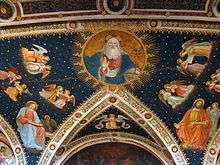San Maurizio al Monastero Maggiore
San Maurizio al Monastero Maggiore is a church in Milan, northern Italy. It was originally attached to the most important female convent of the Benedictines in the city, Monastero Maggiore, which is now in use as the Civic Archaeological Museum. The church today is used every Sunday from October to June to celebrate in the Byzantine Rite, in Greek according to the Italo-Albanian tradition.[1] It is also used as concert hall.
| Church of Saint Maurice al Monastero Maggiore (Chiesa di San Maurizio al Monastero Maggiore) | |
|---|---|
Façade of the church. | |
| Religion | |
| Affiliation | Roman Catholic |
| Province | Milan |
| Year consecrated | 1518 |
| Status | Active |
| Location | |
| Location | Milan, Italy |
| Geographic coordinates | 45.465502°N 9.178921°E |
| Architecture | |
| Architect(s) | Gian Giacomo Dolcebuono; Giovanni Antonio Amadeo |
| Type | Church |
| Style | Renaissance; Baroque |
| Groundbreaking | 1503 |
| Completed | 1518 |
_-_Vedute_di_Milano_-_84_-_Il_Monastero_Maggiore_monache_-_ca._1745.jpg)

History

The complex was founded in Lombard times, partially re-using ancient Roman edifices. Of these there remain a polygonal tower, a relic of the ancient Maximian walls, and a square one, originally part of the lost Hippodrome and later adopted as the church's bell tower. The monastery is now home to Milan's Archaeological Museum.

The construction began in 1503 under design of Gian Giacomo Dolcebuono in collaboration with Giovanni Antonio Amadeo. The edifice was finished fifteen years later by Cristoforo Solari, divided into two parts: one for the faithful, one for the nuns. Until 1794 the latter were strongly forbidden to cross the dividing wall.
Description
The façade is covered with gray stone from Ornavasso.
The interior has a vaulted nave separated by the divisory wall (the nuns followed the mass from a grating) and flanked by groin-vaulted chapels, which are surmounted by a serliana loggia.

The most important artwork of the church is the cycle of frescoes from the 16th century covering the walls. The dividing wall has frescoes depicting the Life of San Maurizio by Bernardino Luini which flank an altarpiece with an Adoration of the Magi by Antonio Campi. The chapels in the faithful's area are by Aurelio Luini, son of Bernardino, and his brothers. The counterfaçade has a fresco by Simone Peterzano (1573). In the right side Bernardino Luini also frescoed the Chapel of St. Catherine of Alexandria (1530). Frescos are also influed by Forlivese school of art (Melozzo da Forlì and Marco Palmezzano).
Hall of nuns
The hall of the nuns is also completely painted. The partition wall, a work by Bernardino Luini always the thirties of the sixteenth century, presents images of Saint Catherine, Saint Agatha, the Marriage at Cana, the Carrying of the Cross of Christ on the Cross and Christ died.
On the vault of the hall of the nuns is depicted a starry sky, with God, the Evangelists, and angels. In the end there is the painting Ecce Homo.
Organ
In the hall of Nuns there is an organ of 1554 by Giovan Giacomo Antegnati entirely by mechanical transmission, consisting of a keyboard of 50 notes and a pedal 20, constantly united to the keyboard.
References
| Wikimedia Commons has media related to San Maurizio (Milan). |
- Fiorio, M.T. (2000). Bernardino Luini e la pittura del Rinascimento a Milano: gli affreschi di San Maurizio al Monastero Maggiore. Milan.
- Bartoli, Francesco (1776–1777). Notizia delle pitture, sculture, ed architetture, che ornano le chiese, e gli altri luoghi pubblici di tutte le più rinomate città d'Italia e di non poche terre, castella, e ville d'alcuni rispettivi distretti. Volume one. Venice: Presso Antonio Savioli. p. 204.
- Specific